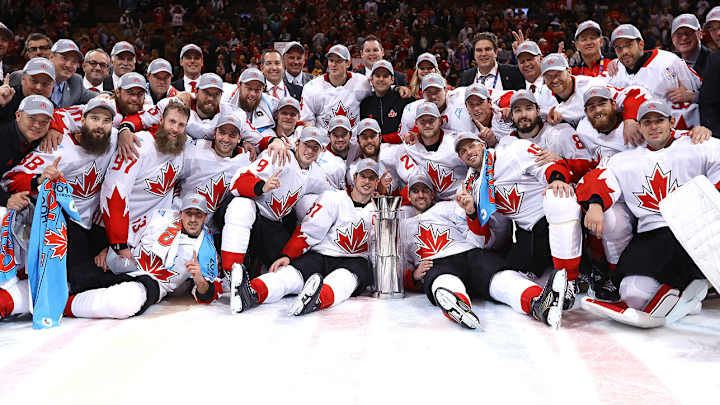World Cup of Hockey shows strengths & shortcomings of new hockey technology

Read about the latest sports tech news, innovations, ideas and products that impact players, fans and the sports industry at SportTechie.com.
As many NHL players dusted off their skates for the World Cup of Hockey last month, the league itself saw the event as an experiment with new technology.
“Whether it’s digitally enhanced dasher boards or puck and player tracking, we’re ready to embrace new technology that isn’t a gimmick,” NHL commissioner Gary Bettman said in an early assessment of the World Cup.
The technology in question, which includes referee cams and tracking chips, has many potential benefits for coaches, broadcasters and fans. For fans, body cameras that were worn by the officials provided a unique perspective. The ref cams captured everything on the ice, including memorable moments like Connor McDavid delivering a precision assist to Auston Matthews and Alex Ovechkin screaming at a ref after his goal was disallowed.
Oh, hello there, Nuge! #TeamNA #WCH2016 pic.twitter.com/nXFotVglpi
— Edmonton Oilers (@EdmontonOilers) September 19, 2016
Coaches, on the other hand, will probably find more value in the new tracking technology. The NHL worked with sports technology innovator Sportvision to embed tracking devices inside the pucks and on the back of player jerseys. To help capture the movements of the puck and players, infrared cameras were placed all around the Air Canada Centre in Toronto, where all the World Cup games took place.
Together, the cameras and tracking chips were able to generate large amounts of data including puck and player speed, distance traveled, puck trajectory, player ice time, zone time, shots, shot distance, shot direction and possession statistics.
However, as with any experiment, not everything went perfectly. “We had an issue early on with shift times,” Sportvision CEO Hank Adams told Yahoo Sports. “When players were going off to the penalty box, [the cameras] weren’t seeing their infrared tags. It was still counting their ice time as they sat there.” (Sportvision later adjusted their cameras to fix the issue.)
Subscribe to the
SportTechie Newsletter
- NFL storylines to watch for the rest of the season
- The Falcons' new stadium is going green
- Orlando Magic will broadcast game on Facebook Live
Small hiccups like that are why the NHL and Sportvision thought it was important to test this technology at the World Cup. They previously used ref cams and tracking chips at the 2015 NHL All-Star Game, but the game didn’t really push the technology hard enough.
“The data that came off the All-Star Game was at all-star speeds, at all-star physicality,” said Steve McArdle, NHL executive vice president of digital media and strategy planning. “It was different.”
That is, the technology was being used in a less competitive environment. By using the technology at the World Cup, the NHL and Sportvision were able to do a proper stress test, examining the system in competitive play over two weeks and 15 games.
Now that the World Cup is over, it’s time for the NHL to think about the potential for Sportvision’s data-gathering technology in actual NHL games. This isn’t the first time the league has been associated with Sportvision. The company’s co-founder, Stanley Honey, previously collaborated with the NHL on the infamous “FoxTrax puck.”
FoxTrax was a cheesy on-screen graphic that made the hockey puck appear to have a blue glow, which turned into a fiery red streak anytime a player shot the puck. The so-called “Glow Puck” was a $2 million failure, but it led to the formation of Sportvision in 1998. The company made its name later that year when it developed the “1st & Ten” graphics system, which first displayed the now famous yellow first down line you see in football games.
Sportvision’s tracking technology certainly has the potential to transform the sport of hockey, as it provides deeper data than has ever been available before. But while the innovation offers some very clear benefits, skeptics question whether those benefits truly outweigh the costs. It’s one thing to plant infrared cameras and tracking chips in one arena for 15 games. It’s a different challenge when you’re talking about 30 different venues and 1,230 regular-season games.
“I’m not underestimating [the cost],” Adams told Yahoo Sports. “To put all of this equipment in stadiums is expensive. So it comes down to how we’re using the data, what the effects are going to be and what is the benefit to the fans. Is it worth it?”
The answer to those questions are debatable. Although analytics is starting to become more popular in hockey, it hasn’t yet revolutionized the sport the way it has for baseball.
“It’ll never replace observation,” Adams said of the data that comes with player tracking. “We can track players and the puck, but that doesn’t tell you possession. The puck may be closer to another player, but I have possession of it. There’s always going to be an element of human intervention.”
